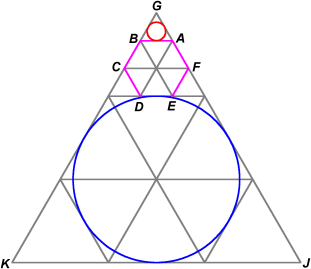Difference between revisions of "2010 AMC 10B Problems/Problem 20"
AceOfClubs (talk | contribs) (Added Solution (no diagram)) |
AceOfClubs (talk | contribs) m (→Solution) |
||
| Line 24: | Line 24: | ||
From this, it's evident that the ratio of the red area to the blue area is equal to the '''ratio of the areas of triangles <math>GKJ</math> to <math>GBA</math>''' | From this, it's evident that the ratio of the red area to the blue area is equal to the '''ratio of the areas of triangles <math>GKJ</math> to <math>GBA</math>''' | ||
| − | Since the ratio of areas is equal to the square of the ratio of lengths, we | + | Since the ratio of areas is equal to the square of the ratio of lengths, we know our final answer is <math>\left(\frac{GK}{GB}\right)^2</math> |
From the diagram, we can see that this is <math>9^2=\boxed{81}</math> | From the diagram, we can see that this is <math>9^2=\boxed{81}</math> | ||
The letter answer is '''D''' | The letter answer is '''D''' | ||
Revision as of 00:18, 21 January 2011
Problem
Two circles lie outside regular hexagon ![]() . The first is tangent to $\overbar{AB}$ (Error compiling LaTeX. Unknown error_msg), and the second is tangent to $\overbar{DE}$ (Error compiling LaTeX. Unknown error_msg). Both are tangent to lines
. The first is tangent to $\overbar{AB}$ (Error compiling LaTeX. Unknown error_msg), and the second is tangent to $\overbar{DE}$ (Error compiling LaTeX. Unknown error_msg). Both are tangent to lines ![]() and
and ![]() . What is the ratio of the area of the second circle to that of the first circle?
. What is the ratio of the area of the second circle to that of the first circle?
![]()
Solution
A good diagram here is very helpful.
The first circle is in red, the second in blue.
With this diagram, we can see that the first circle is inscribed in equilateral triangle ![]() while the second circle is inscribed in
while the second circle is inscribed in ![]() .
From this, it's evident that the ratio of the red area to the blue area is equal to the ratio of the areas of triangles
.
From this, it's evident that the ratio of the red area to the blue area is equal to the ratio of the areas of triangles ![]() to
to ![]()
Since the ratio of areas is equal to the square of the ratio of lengths, we know our final answer is ![]() From the diagram, we can see that this is
From the diagram, we can see that this is ![]()
The letter answer is D










